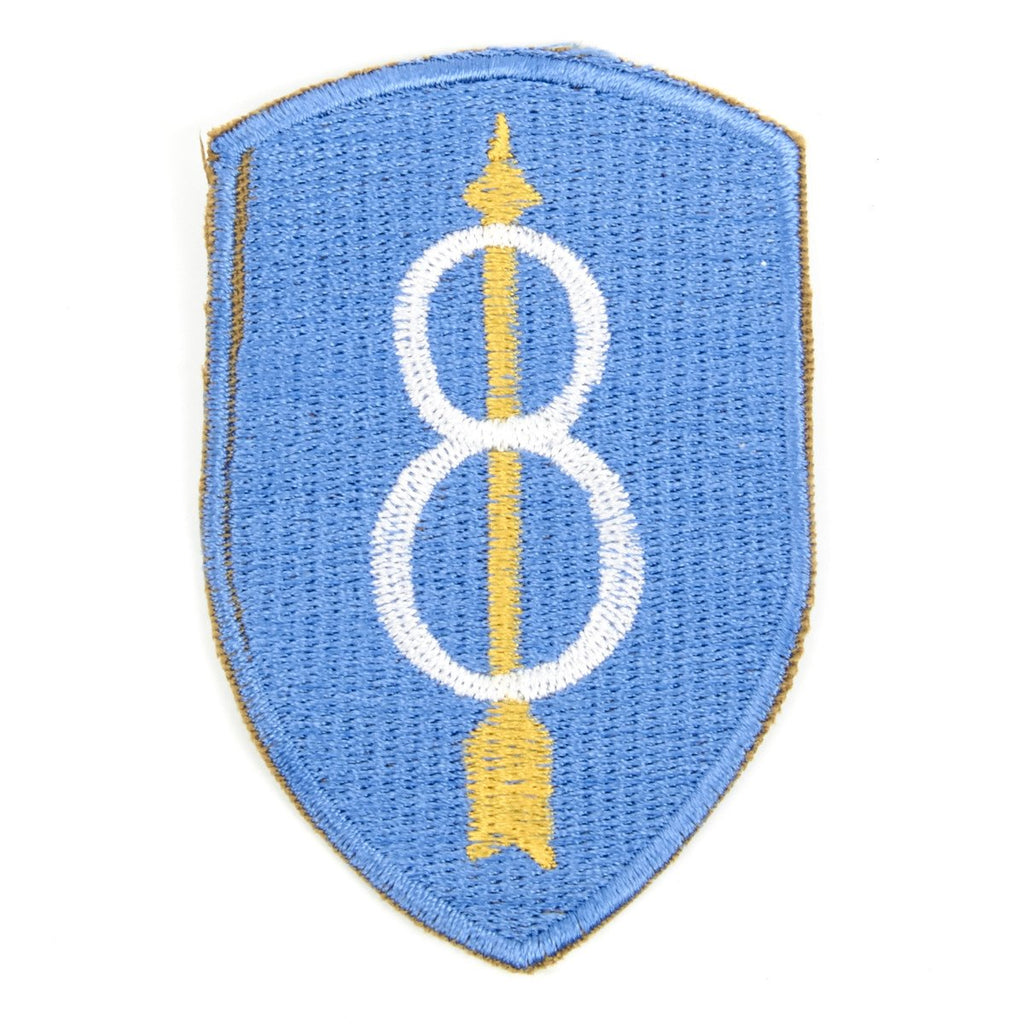-
New Made Item: Top quality embroidery. The 8th Infantry Division, ("Pathfinder") was an infantry division of the United States Army during the 20th century. The division served in World War I, World War II, and Operation Desert Storm. Initially activated in January 1918, the unit did not see combat during World War I and returned to the United States. Activated again on 1 July 1940 as part of the build-up of military forces prior to the United States' entry into World War II, the division saw extensive action in the European Theatre of Operations. Following World War II, the division was moved to West Germany, where it remained stationed at the Rose Barracks in Bad Kreuznach until it was inactivated on 17 January 1992.
Approximate dimensions:
3..25" H x 2" W
WW2 Combat chronicle:
During World War II, the 8th Infantry Division was sent to Europe to fight against the Axis. After training in Ireland the 8th Infantry Division landed on Omaha Beach, Normandy, 4 July 1944, and entered combat on 7 July. Shortly after its arrival, the division captured the French cities of Rennes and Brest. Fighting through the hedgerows, it crossed the Ay River, 26 July, pushed through Rennes, 8 August, and attacked Brest in September. When U.S. Brigadier General Charles Canham, who was at the time the deputy commander of the 8th Infantry Division, arrived to accept the surrender of German troops in Brest, the commander of the Brest garrison, General Hermann-Bernhard Ramcke asked the lower-ranking man to show his credentials. Canham pointed to his nearby troops and said "These are my credentials". That phrase has since become the 8th Infantry Division's motto.
Following these actions, the 8th turned eastward toward the German border, taking part in the heavy fighting in the Hürtgen Forest in November 1944. The Crozon Peninsula was cleared on 19 September, and the division drove across France to Luxembourg, moved to the Hurtgen Forest, 20 November, cleared Hurtgen on the 28th and Brandenberg, 3 December, and pushed on to the Roer. That river was crossed on 23 February 1945, Duren taken on the 25th and the Erft Canal crossed on the 28th. The 8th reached the Rhine near Rodenkirchen, 7 March, and maintained positions along the river near Koln. In early March 1945, the 8th had advanced into the Rhineland. It fought its way into the Ruhr region the following month.
On 6 April the division attacked northwest to aid in the destruction of enemy forces in the Ruhr Pocket, and by the 17th had completed its mission. After security duty, the division, under operational control of the British Second Army, drove across the Elbe, 1 May, and penetrated to Schwerin when the war in Europe ended.
On 2 May 1945, as it advanced into northern Germany, the 8th Infantry Division encountered the Neuengamme prison camp Wöbbelin subcamp, near the city of Ludwigslust. The SS had established Wöbbelin in early February 1945 to house prison camp prisoners who had been evacuated from other NSDAP camps to prevent their liberation by the Allies. Wöbbelin held some 5,000 inmates, many of whom suffered from starvation and disease. The sanitary conditions at the camp when the 8th Infantry Division and the 82nd Airborne Division arrived were deplorable. There was little food or water, and some prisoners had resorted to cannibalism. In the first week after liberation, more than 200 inmates died. In the aftermath, the United States Army ordered the townspeople in Ludwigslust to visit the camp and bury the dead.
The 8th Infantry Division was recognized as a liberating unit by the U.S. Army's Center of Military History and the United States Shoah Memorial Museum in 1988.
- This product is available for international shipping.
- Eligible for all payments - Visa, Mastercard, Discover, AMEX, Paypal & Sezzle


We Buy Military Antiques
Our team expert buyers travels the world to pay fair prices for entire estate collections to singular items.
START SELLING TODAY



